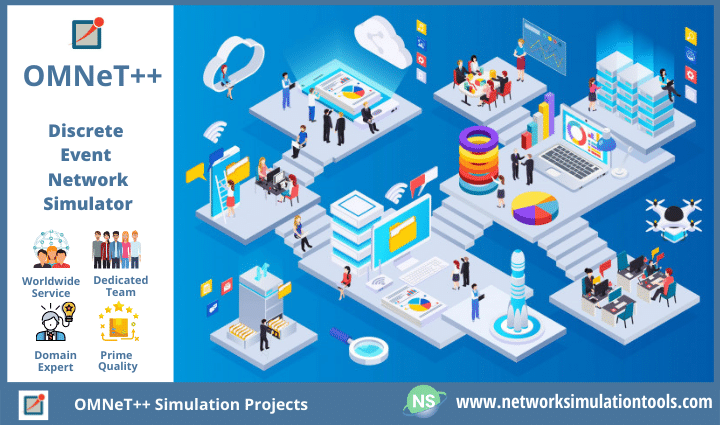OMNET++ Simulation Projects for B.E with wired and wireless communication networks. OMNET ++ an object-oriented, modular, and component-based c++ simulation library composed of various frameworks to build new network simulators.
We ensure a framework to investigate various simulation environments. In this support OMNET ++ with various hardware wired computer network simulation scenarios for students projects. We develop various applications in OMNET ++ under various simulation models and frameworks.

We adopt the following characteristics in the final year project are
Mobile Adhoc network composed of various mobile devices ensures communication with every device without any infrastructure or administrator. MANET is referred to as the self-configuring network, and every node in MANET is connected by wireless links and acts as a router and host.
The network router performs packet forwarding function from one place to another place. Network hosts in MANET receive data forwarded by the source node. We provide IEEE based papers in OMNET ++ simulation projects. We also simulate OMNET ++ with MANET network and categorized as three types they are:
We use a wireless sensor network composed of the spatially distributed autonomous device using a sensor to monitor physical environmental conditions such as pressure, sound, and also temperature. Every sensor node has sensing capacity with neighboring modes.
To simulate a sensor network with OMNET ++, we provide component-based architecture and an INET framework. By the INET framework, we ensured more than 110+ projects with various applications and wireless sensor network simulations.
An emerging technology called p2p to reduce obstacle of stream live events over internet. It is referred to as an overlay network; every node simultaneously functions as a client and server.
In this model, we also ensure that nodes have we or part of the requested media to forward the requesting nodes. In this way, no nodes are increased, and each node contributes its own resource to produce a capacity of the entire system. We also implement p2p with OMNET++ Simulation Projects called a client-server model.
Reorganized streaming and p2p overlay provide highly scalable and low cost, which lowered the barrier to stream live events over the internet. By this process, we ensure good quality of service to end-users. We also define the quality of service in two terms are:
QoS ensures high playback continuity of node with receive data block stream with certain time constraints. We also reduce the quality of playback when it disrupts continuity.
| Technology | Ph.D | MS | M.Tech |
|---|---|---|---|
| NS2 | 75 | 117 | 95 |
| NS3 | 98 | 119 | 206 |
| OMNET++ | 103 | 95 | 87 |
| OPNET | 36 | 64 | 89 |
| QULANET | 30 | 76 | 60 |
| MININET | 71 | 62 | 74 |
| MATLAB | 96 | 185 | 180 |
| LTESIM | 38 | 32 | 16 |
| COOJA SIMULATOR | 35 | 67 | 28 |
| CONTIKI OS | 42 | 36 | 29 |
| GNS3 | 35 | 89 | 14 |
| NETSIM | 35 | 11 | 21 |
| EVE-NG | 4 | 8 | 9 |
| TRANS | 9 | 5 | 4 |
| PEERSIM | 8 | 8 | 12 |
| GLOMOSIM | 6 | 10 | 6 |
| RTOOL | 13 | 15 | 8 |
| KATHARA SHADOW | 9 | 8 | 9 |
| VNX and VNUML | 8 | 7 | 8 |
| WISTAR | 9 | 9 | 8 |
| CNET | 6 | 8 | 4 |
| ESCAPE | 8 | 7 | 9 |
| NETMIRAGE | 7 | 11 | 7 |
| BOSON NETSIM | 6 | 8 | 9 |
| VIRL | 9 | 9 | 8 |
| CISCO PACKET TRACER | 7 | 7 | 10 |
| SWAN | 9 | 19 | 5 |
| JAVASIM | 40 | 68 | 69 |
| SSFNET | 7 | 9 | 8 |
| TOSSIM | 5 | 7 | 4 |
| PSIM | 7 | 8 | 6 |
| PETRI NET | 4 | 6 | 4 |
| ONESIM | 5 | 10 | 5 |
| OPTISYSTEM | 32 | 64 | 24 |
| DIVERT | 4 | 9 | 8 |
| TINY OS | 19 | 27 | 17 |
| TRANS | 7 | 8 | 6 |
| OPENPANA | 8 | 9 | 9 |
| SECURE CRT | 7 | 8 | 7 |
| EXTENDSIM | 6 | 7 | 5 |
| CONSELF | 7 | 19 | 6 |
| ARENA | 5 | 12 | 9 |
| VENSIM | 8 | 10 | 7 |
| MARIONNET | 5 | 7 | 9 |
| NETKIT | 6 | 8 | 7 |
| GEOIP | 9 | 17 | 8 |
| REAL | 7 | 5 | 5 |
| NEST | 5 | 10 | 9 |
| PTOLEMY | 7 | 8 | 4 |